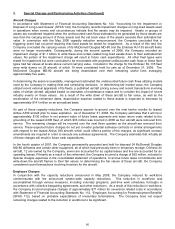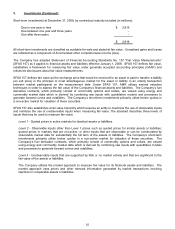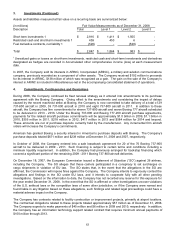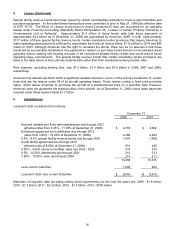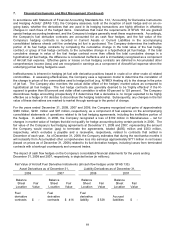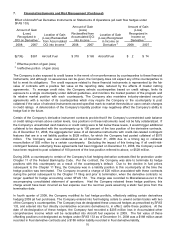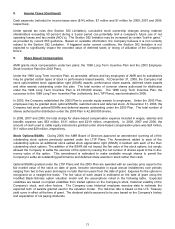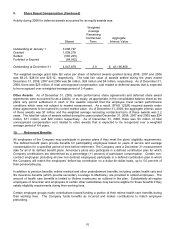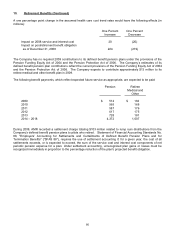American Airlines 2008 Annual Report Download - page 73
Download and view the complete annual report
Please find page 73 of the 2008 American Airlines annual report below. You can navigate through the pages in the report by either clicking on the pages listed below, or by using the keyword search tool below to find specific information within the annual report.
70
7. Financial Instruments and Risk Management (Continued)
Effect of Aircraft Fuel Derivative Instruments on Statements of Operations (all cash flow hedges under
SFAS 133)
Amount of Gain
(Loss)
Recognized in
OCI on Derivative1
Location of Gain
(Loss) Reclassified
from Accumulated
OCI into Income 1
Amount of Gain
(Loss)
Reclassified from
Accumulated OCI
into Income
1
Location of Gain
(Loss) Recognized
in Income on
Derivative
2
Amount of Gain
(Loss)
Recognized in
Income on
Derivative
2
2008
2007
2008
2007
2008
2007
$(738)
$381
Aircraft Fuel
$ 378
$ 165
Aircraft Fuel
$ 2
$ 74
1 Effective portion of gain (loss)
2 Ineffective portion of gain (loss)
The Company is also exposed to credit losses in the event of non-performance by counterparties to these financial
instruments, and although no assurances can be given, the Company does not expect any of the counterparties to
fail to meet its obligations. The credit exposure related to these financial instruments is represented by the fair
value of contracts with a positive fair value at the reporting date, reduced by the effects of master netting
agreements. To manage credit risks, the Company selects counterparties based on credit ratings, limits its
exposure to a single counterparty under defined guidelines, and monitors the market position of the program and
its relative market position with each counterparty. The Company also maintains industry-standard security
agreements with a number of its counterparties which may require the Company or the counterparty to post
collateral if the value of selected instruments exceed specified mark-to-market thresholds or upon certain changes
in credit ratings. A deterioration of the Company’s liquidity position may negatively affect the Company’s ability to
hedge fuel in the future.
Certain of the Company’s derivative instrument contracts provide that if the Company’s unrestricted cash balance
or credit ratings remain above certain levels, loss positions on these instruments need not be fully collateralized. If
the Company’s unrestricted cash balance or credit rating were to fall below these levels, it would trigger additional
collateral to be deposited with the counterparty up to 100 percent of the loss position of the derivative contracts.
As of December 31, 2008, the aggregate fair value of all derivative instruments with credit-risk-related contingent
features that are in a net liability position is $528 million, for which the Company had posted collateral of $575
million. The Company was over-collateralized as of December 31, 2008 due to a timing lag in collateral
reconciliation of $92 million by a certain counterparty. Excluding the impact of this timing lag, if all credit-risk-
contingent features underlying these agreements had been triggered on December 31, 2008, the Company would
have been required to post collateral of 100 percent of the loss position referred to above, or $528 million.
During 2008, a counterparty to certain of the Company’s fuel hedging derivative contracts filed for protection under
Chapter 11 of the Federal Bankruptcy Code. Per the contract, the Company was able to terminate its hedge
positions with this counterparty as a result of the counterparty’s default. Due to the decline in fuel prices
subsequent to the Chapter 11 filing, the Company was in a liability position to this counterparty at the time the
hedge position was terminated. The Company incurred a charge of $26 million associated with these contracts
during the period subsequent to the Chapter 11 filing and prior to termination, when the derivative contracts no
longer qualified for hedge accounting under SFAS 133. The charge was recorded to Miscellaneous-net in the
accompanying consolidated statement of operations. Had the Company retained these hedge positions, this
charge would have been incurred as fuel expense over the next two years assuming a static fuel price from the
termination date.
In fourth quarter of 2008, the Company modified its fuel hedge portfolio, effectively settling certain derivatives
hedging 2009 jet fuel purchases. The Company entered into fuel hedging collars to unwind certain trades with two
of the Company’s counterparties. The Company has de-designated these unwound hedges as prescribed by SFAS
133, and entered into four directly counteractive economic derivatives to, in effect, settle these positions. At the
date of de-designation of these hedges, the Company had recorded a $205 million loss in Accumulated other
comprehensive income which will be reclassified into Aircraft fuel expense in 2009. The fair value of these
offsetting positions not designated as hedges under SFAS 133 as of December 31, 2008 was a $188 million asset
recorded in Fuel derivative contracts and a $188 million liability recorded in Fuel derivative liability.


